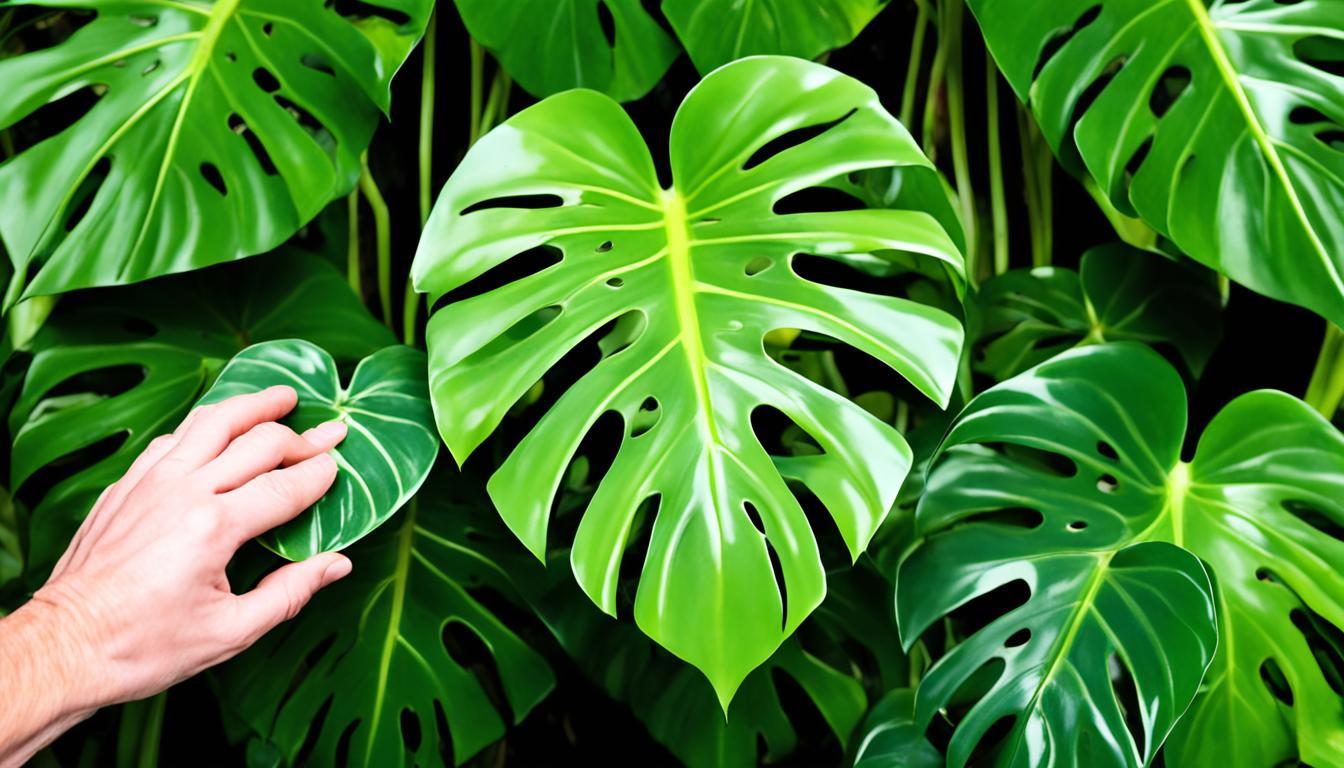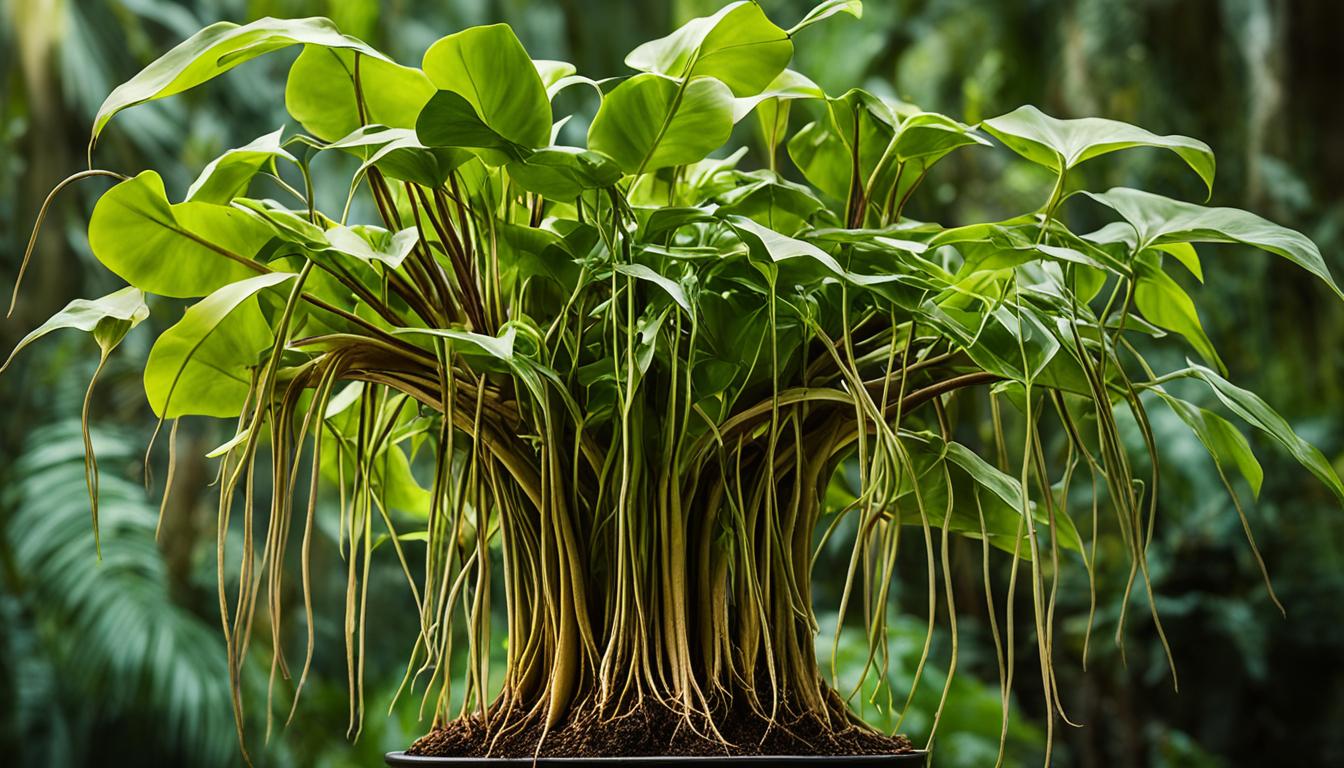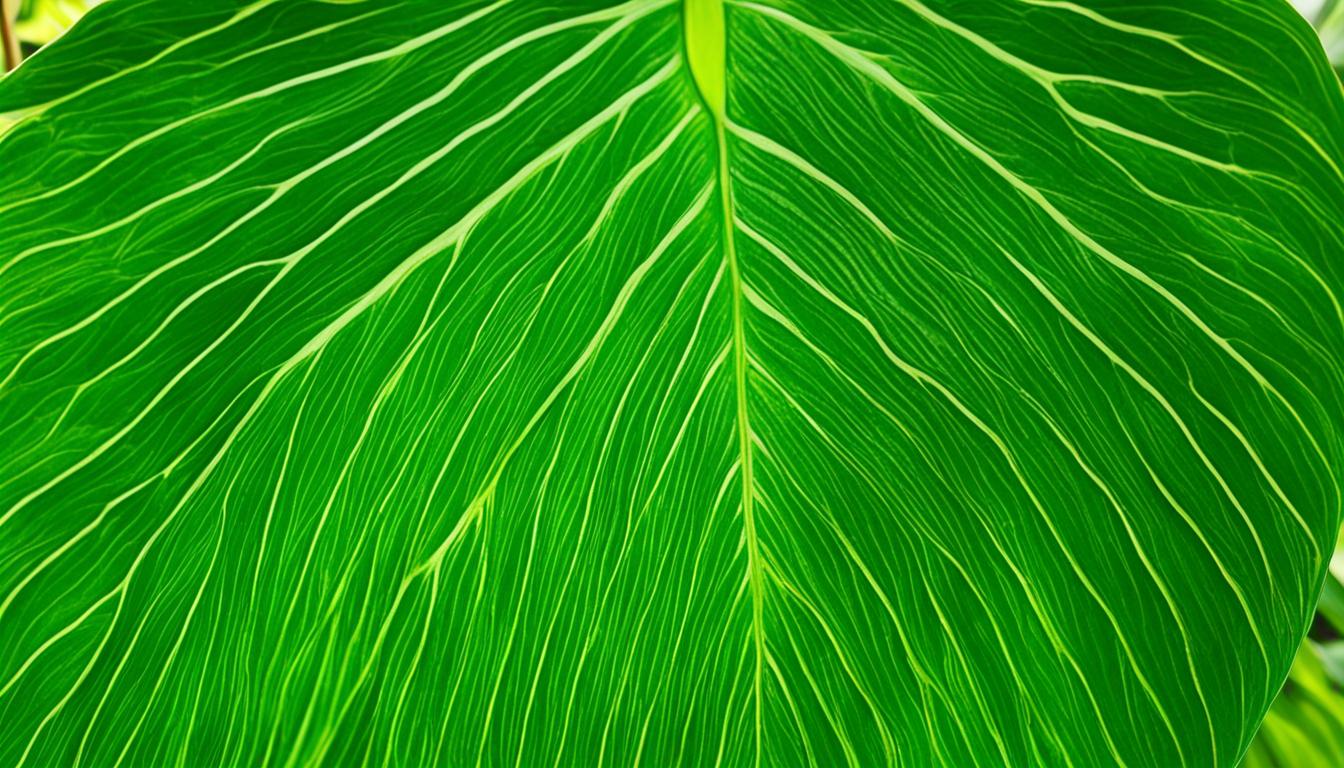Did you know there are over 450 types of philodendrons? Each one has different leaf shapes, sizes, and colors. They are a wonder to look at, attracting nature lovers everywhere with their colorful leaves. This guide will show you the beauty of plants like the Rojo Congo with its bold leaves and the fernleaf philodendron with its fragile fronds.
Key Takeaways
-
Philodendrons come in over 450 unique species and cultivars, each with its own distinctive leaf shape, size, color, and texture.
-
These tropical plants are known for their easy-care nature and ability to thrive in a variety of indoor environments.
-
From the bold, dramatic Rojo Congo to the delicate, lacy fernleaf philodendron, the genus offers a stunning diversity of foliage.
-
Philodendrons can exhibit fascinating changes in leaf form as the plant matures, from juvenile to mature foliage.
-
Proper identification and care are key to ensuring philodendrons display their full, vibrant leaf potential.
Introduction to Philodendrons
The philodendron plant family belongs to the Araceae group. It has over 450 species and types. These plants come from the Americas’ tropical areas, mainly from Central and South America’s rainforests. They stand out with their different leaf shapes and colors.
Philodendrons have leaves that can be heart-shaped or deeply lobed. You can find them in many colors, like bright green to deep black. They grow differently too, with some climbing and others staying bushy.
Overview of the Philodendron Plant Family
The philodendron family is famous for its many types.
There’s something for everyone, from the tall Philodendron bipinnatifidum to the unique Philodendron Birkin. Other favorites include the Rojo Congo, the Xanadu, and the Ring of Fire. Each one has its own style and charm.
What’s cool is that some plants look different as they grow. This means new surprises each time you see your plant. Whether you like bright colors or unique shapes, the philodendron family has it all.
Diversity of Philodendron Species and Varieties
The philodendron genus has so much variety. With hundreds of different kinds, you’re sure to find one you love.
Choose from glossy Philodendron bipinnatifidum to the eye-catching Philodendron Birkin. There’s also the Rojo Congo, the Xanadu, and the Ring of Fire. These plants have leaves that change as they grow, making them even more interesting.
No matter what you’re looking for, the philodendron family has a plant just for you.
Leaf Characteristics of Philodendrons
Philodendrons have unique and beautiful leaf shapes and patterns. They come in many forms, from hearts to horse heads. Some, like the Philodendron Brandtianum, have white patterns. The Philodendron Birkin has bold stripes.
Textures and Colors of Philodendron Leaves
Philodendron leaves vary in texture and color, making them visually appealing. Some, like the Philodendron micans, have a soft, velvety feel. Others, like the Philodendron Rojo Congo, are shiny and smooth. Leaf colors can be bright green, gold, or deep red. The Philodendron Black Cardinal is nearly black. When they’re young, leaves might be red or orange before turning green.
Leaf Size Variations Among Philodendrons
Philodendron leaves range in size from very small to very large. The Heartleaf philodendron has small, 2-3-inch leaves. The Philodendron Billietiae has big, 3-foot-long fronds. Different sizes fit any indoor space well. The Philodendron Prince of Orange is great for small homes. Larger types, like the Philodendron Bipinnatifidum, fill big spaces nicely. All philodendrons bring beauty and greenery to any room.
Stem and Growth Habits
Philodendrons come in two main types: climbing and non-climbing. Climbing types, like Philodendron Atabapoense, use aerial roots to climb. They’re great for hanging or as floor plants. Non-climbing types, such as Philodendron Xanadu, are more bushy. They do well on shelves or tables. Knowing how your philodendron grows helps it do its best.
Aerial Roots and Their Function
All philodendrons have aerial roots along their stems. These roots are very important. For climbers, like Philodendron Bob Cee, the roots help them climb and get water and food from the air. Non-climbers, such as Philodendron Imperial Green, also have these roots. They can help support the plant or trail over pots. Taking care of aerial roots keeps the plant healthy and strong.
What Does Philodendron Look Like?
Philodendrons have many leaf shapes and colors. Each type is different. Some popular types are the Rojo Congo, the Xanadu, the Ring of Fire, and the Philodendron Hope. Others include the velvety Philodendron micans and the variegated Philodendron Birkin. The philodendron family offers plants with bold colors or unique shapes.
Rare and Unique Philodendron Appearances
There are also rare philodendrons with special looks. The Philodendron Billietiae has large, jade-green leaves up to 3 feet long. Another is the Philodendron Brandtianum, known for its silver streaks. The fast-growing Philodendron Bipinnatifidum impresses with broad leaves and pale veins. These unique philodendrons are loved by plant enthusiasts.
Philodendron Leaf Changes and Variations
Philodendrons change a lot as they grow, showing us many leaf types. Young ones, like the Philodendron Bipinnatifidum and Philodendron Billietiae, start small and maybe look different. But as they grow, their leaves change a lot. They might go from red to green, or from lacey to wide and flat. This change is a big part of what makes philodendrons so interesting.
Environmental Factors Influencing Leaf Appearance
How a philodendron’s leaves look is influenced by where and how it grows. Light, humidity, and soil affect the color, feel, and shape of the leaves. Lots of light makes their colors stand out, but if it’s too dark, they might look dull. If it’s very humid, leaves feel soft, but in dry places, they might be tough. The right conditions help these plants show their true beauty.
Identifying and Caring for Philodendrons
It can be hard to tell philodendrons apart because they have so many different leaf shapes and colors. Yet, there are a few things that make them stand out from plants like pothos. Philodendrons often have leaves that are smooth and thin with either a heart or arrow shape. They also have cataphylls, which are paper-like covers around new leaf growth.
Moreover, philodendrons usually show off slender, colored stems and many thin aerial roots. This is different from pothos, which have thicker stems and only a few aerial roots. By looking closely at a plant’s leaves and how it grows, you can figure out if it’s a philodendron or not.
Tips for Proper Philodendron Identification
Philodendrons love bright, indirect light and humid spaces. They should be in moist, but not soggy, soil. To keep your philodendron happy, avoid overwatering and let the soil never get completely dry. They thrive when you mist them often or put them in a humid area because they come from the tropics.
Every couple of months, giving them some diluted liquid fertilizer is a good idea. This keeps their leaves bright and colorful. To grow a healthy philodendron that resembles a tropical paradise, provide the right amount of light, water, and care.
Basic Care Requirements for Healthy Philodendrons
Philodendrons are pretty easy to take care of, but they have a few needs for them to do well. They like bright, indirect light and moist soil. It’s not good to overwater them because it can cause their roots to rot.
Philodendrons enjoy humidity because they are tropical plants. Misting them or putting them in a humid place will make them thrive better. Feeding them with a diluted liquid fertilizer every 2-3 months keeps them healthy and their leaves bright. With the right amount of light, water, and care, your philodendron will flourish and bring a tropical feel to your home.
Conclusion
Philodendrons are amazing plants with a wide variety of leaf shapes and colors. You’ll love the Rojo Congo for its bold leaves and the Fernleaf Philodendron for its delicate fronds. By picking the right type of philodendron, you can make your home beautiful with these tropical houseplants.
If you’re into plants or just starting, philodendrons are a great choice. They bring vibrant colors and interesting leaf shapes to your home. They are also easy to take care of. Adding these plants to your space can make it feel like a green paradise. Let these lovely plants spark your love for gardening.
Take good care of your philodendrons. They will give you joy for many years. Don’t wait any longer. Start your philodendron journey today. Let these tropical wonders make your home a better place.
<div class="quiz-container">
<h1> What Does Philodendron Look Like? Discover Its Appearance </h1>
<form id="philodendron-appearance-quiz">
<div class="question">
<h2>1. What is the typical color of a Philodendron's leaves?</h2>
<label>
<input type="radio" name="q1" value="a"> Green
</label>
<label>
<input type="radio" name="q1" value="b"> Blue
</label>
<label>
<input type="radio" name="q1" value="c"> Red ❤️
</label>
<label>
<input type="radio" name="q1" value="d"> Yellow
</label>
</div>
<div class="question">
<h2>2. How would you describe the shape of Philodendron leaves?</h2>
<label>
<input type="radio" name="q2" value="a"> Heart-shaped
</label>
<label>
<input type="radio" name="q2" value="b"> Round ⚪
</label>
<label>
<input type="radio" name="q2" value="c"> Star-shaped ⭐
</label>
<label>
<input type="radio" name="q2" value="d"> Needle-like
</label>
</div>
<div class="question">
<h2>3. What is a common feature of Philodendron stems?</h2>
<label>
<input type="radio" name="q3" value="a"> Thorny
</label>
<label>
<input type="radio" name="q3" value="b"> Smooth and thick
</label>
<label>
<input type="radio" name="q3" value="c"> Fragile and thin ❌
</label>
<label>
<input type="radio" name="q3" value="d"> Woody
</label>
</div>
<div class="question">
<h2>4. What kind of variegation can some Philodendrons have?</h2>
<label>
<input type="radio" name="q4" value="a"> White stripes
</label>
<label>
<input type="radio" name="q4" value="b"> Purple spots
</label>
<label>
<input type="radio" name="q4" value="c"> Black edges ⚫
</label>
<label>
<input type="radio" name="q4" value="d"> Blue veins
</label>
</div>
<div class="question">
<h2>5. How do Philodendrons typically grow?</h2>
<label>
<input type="radio" name="q5" value="a"> As trees
</label>
<label>
<input type="radio" name="q5" value="b"> As climbing vines
</label>
<label>
<input type="radio" name="q5" value="c"> As ground cover
</label>
<label>
<input type="radio" name="q5" value="d"> As bushes
</label>
</div>
<button type="button" onclick="checkAnswers()">Submit</button>
</form>
<div id="results"></div>
</div>
<style>
.quiz-container {
font-family: Arial, sans-serif;
max-width: 600px;
margin: auto;
padding: 20px;
border: 2px solid #4CAF50;
border-radius: 10px;
background-color: #f9f9f9;
}
h1 {
text-align: center;
color: #4CAF50;
}
.question {
margin-bottom: 20px;
}
label {
display: block;
margin: 5px 0;
}
button {
display: block;
width: 100%;
padding: 10px;
background-color: #4CAF50;
color: white;
border: none;
border-radius: 5px;
cursor: pointer;
}
button:hover {
background-color: #45a049;
}
#results {
margin-top: 20px;
text-align: center;
}
</style>
<script>
function checkAnswers() {
const answers = {
q1: 'a',
q2: 'a',
q3: 'b',
q4: 'a',
q5: 'b'
};
let score = 0;
const form = document.getElementById('philodendron-appearance-quiz');
const results = document.getElementById('results');
const formData = new FormData(form);
formData.forEach((value, key) => {
if (value === answers[key]) {
score++;
}
});
results.innerHTML = `<h2>Your Score: ${score}/5</h2>`;
if (score === 5) {
results.innerHTML += `<p> Excellent! You truly know what a Philodendron looks like! </p>`;
} else if (score >= 3) {
results.innerHTML += `<p> Good job! You're well on your way to being a Philodendron expert! </p>`;
} else {
results.innerHTML += `<p> Keep learning and you'll be a Philodendron pro in no time! </p>`;
}
}
</script>
What Does Philodendron Look Like? Discover Its Appearance
Relevant Articles:
Source Links
what-does-philodendron-look-like
Related Topics You May Enjoy


